HNN215 Case Study: Risks Associated with Medication Use in Mr. Jedda
VerifiedAdded on 2022/09/15
|9
|2396
|8
Case Study
AI Summary
This case study examines the medication regimen of an 84-year-old patient, Mr. Michael Jedda, who is prescribed multiple medications for hypertension, congestive heart failure, and atrial fibrillation. The assignment focuses on the potential risks associated with these medications, including bleeding due to the interaction of warfarin with other drugs like clarithromycin, benzylpenicillin, and spironolactone. Hypotension risks are also analyzed, considering the combined effects of ramipril, spironolactone, bisoprolol, and oxycodone, along with the patient's renal impairment. The case study emphasizes the nursing role in preventing and managing these risks through regular vital sign monitoring, continuous patient assessment, INR level checks, patient education, and adherence to the rights of drug administration. The nurse's responsibility includes anticipating and mitigating potential adverse effects and drug interactions to ensure patient safety and prevent complications.
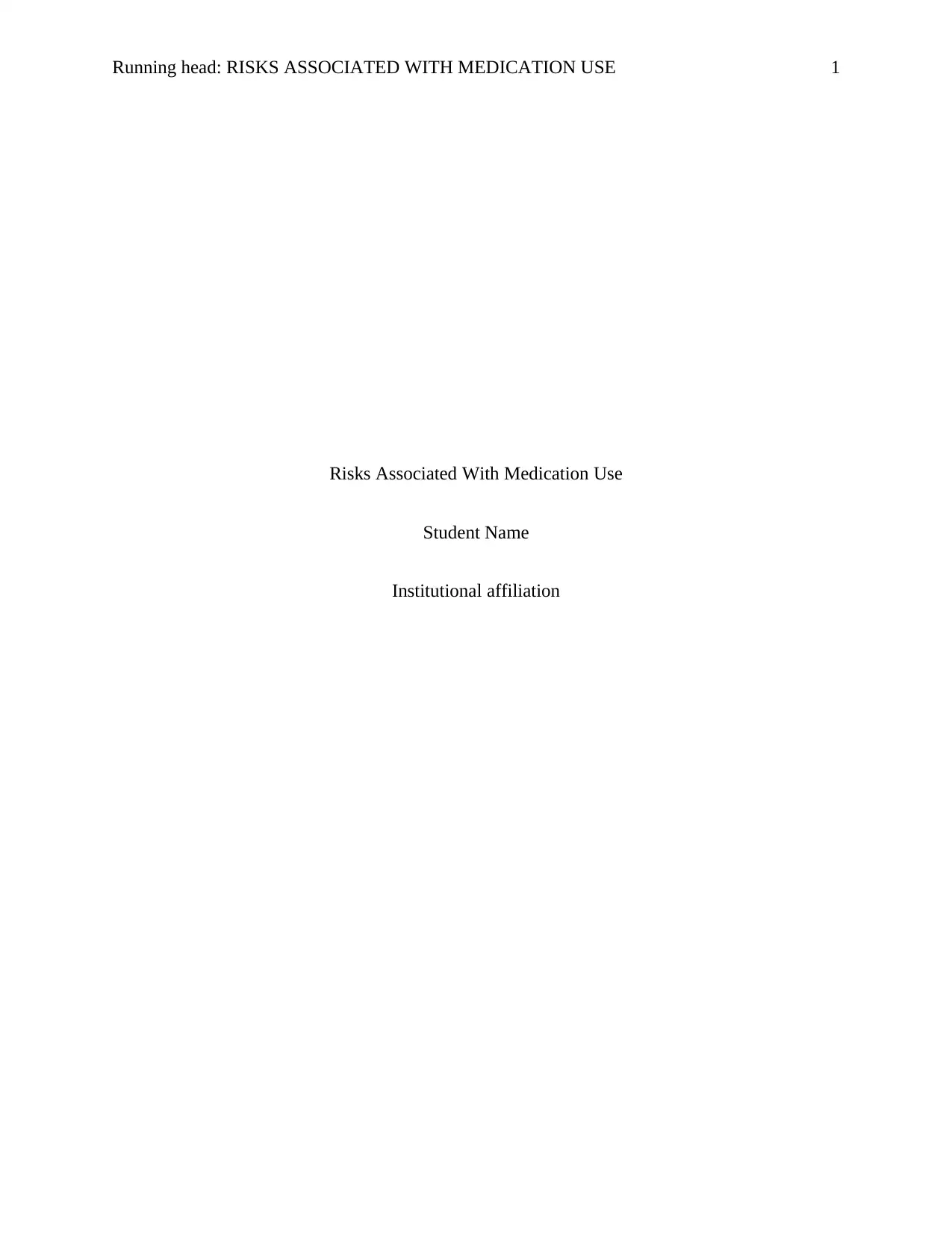
Running head: RISKS ASSOCIATED WITH MEDICATION USE 1
Risks Associated With Medication Use
Student Name
Institutional affiliation
Risks Associated With Medication Use
Student Name
Institutional affiliation
Paraphrase This Document
Need a fresh take? Get an instant paraphrase of this document with our AI Paraphraser
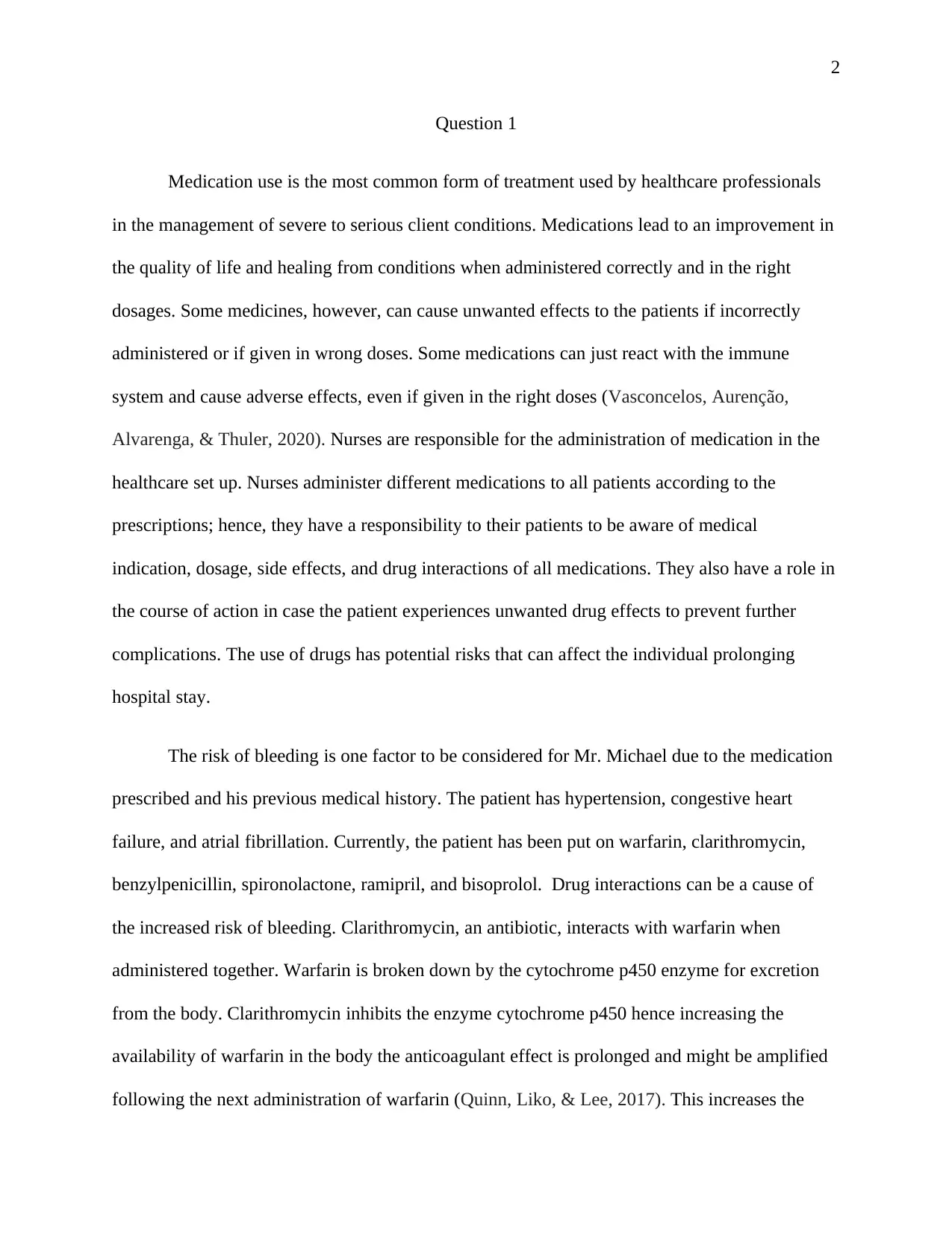
2
Question 1
Medication use is the most common form of treatment used by healthcare professionals
in the management of severe to serious client conditions. Medications lead to an improvement in
the quality of life and healing from conditions when administered correctly and in the right
dosages. Some medicines, however, can cause unwanted effects to the patients if incorrectly
administered or if given in wrong doses. Some medications can just react with the immune
system and cause adverse effects, even if given in the right doses (Vasconcelos, Aurenção,
Alvarenga, & Thuler, 2020). Nurses are responsible for the administration of medication in the
healthcare set up. Nurses administer different medications to all patients according to the
prescriptions; hence, they have a responsibility to their patients to be aware of medical
indication, dosage, side effects, and drug interactions of all medications. They also have a role in
the course of action in case the patient experiences unwanted drug effects to prevent further
complications. The use of drugs has potential risks that can affect the individual prolonging
hospital stay.
The risk of bleeding is one factor to be considered for Mr. Michael due to the medication
prescribed and his previous medical history. The patient has hypertension, congestive heart
failure, and atrial fibrillation. Currently, the patient has been put on warfarin, clarithromycin,
benzylpenicillin, spironolactone, ramipril, and bisoprolol. Drug interactions can be a cause of
the increased risk of bleeding. Clarithromycin, an antibiotic, interacts with warfarin when
administered together. Warfarin is broken down by the cytochrome p450 enzyme for excretion
from the body. Clarithromycin inhibits the enzyme cytochrome p450 hence increasing the
availability of warfarin in the body the anticoagulant effect is prolonged and might be amplified
following the next administration of warfarin (Quinn, Liko, & Lee, 2017). This increases the
Question 1
Medication use is the most common form of treatment used by healthcare professionals
in the management of severe to serious client conditions. Medications lead to an improvement in
the quality of life and healing from conditions when administered correctly and in the right
dosages. Some medicines, however, can cause unwanted effects to the patients if incorrectly
administered or if given in wrong doses. Some medications can just react with the immune
system and cause adverse effects, even if given in the right doses (Vasconcelos, Aurenção,
Alvarenga, & Thuler, 2020). Nurses are responsible for the administration of medication in the
healthcare set up. Nurses administer different medications to all patients according to the
prescriptions; hence, they have a responsibility to their patients to be aware of medical
indication, dosage, side effects, and drug interactions of all medications. They also have a role in
the course of action in case the patient experiences unwanted drug effects to prevent further
complications. The use of drugs has potential risks that can affect the individual prolonging
hospital stay.
The risk of bleeding is one factor to be considered for Mr. Michael due to the medication
prescribed and his previous medical history. The patient has hypertension, congestive heart
failure, and atrial fibrillation. Currently, the patient has been put on warfarin, clarithromycin,
benzylpenicillin, spironolactone, ramipril, and bisoprolol. Drug interactions can be a cause of
the increased risk of bleeding. Clarithromycin, an antibiotic, interacts with warfarin when
administered together. Warfarin is broken down by the cytochrome p450 enzyme for excretion
from the body. Clarithromycin inhibits the enzyme cytochrome p450 hence increasing the
availability of warfarin in the body the anticoagulant effect is prolonged and might be amplified
following the next administration of warfarin (Quinn, Liko, & Lee, 2017). This increases the
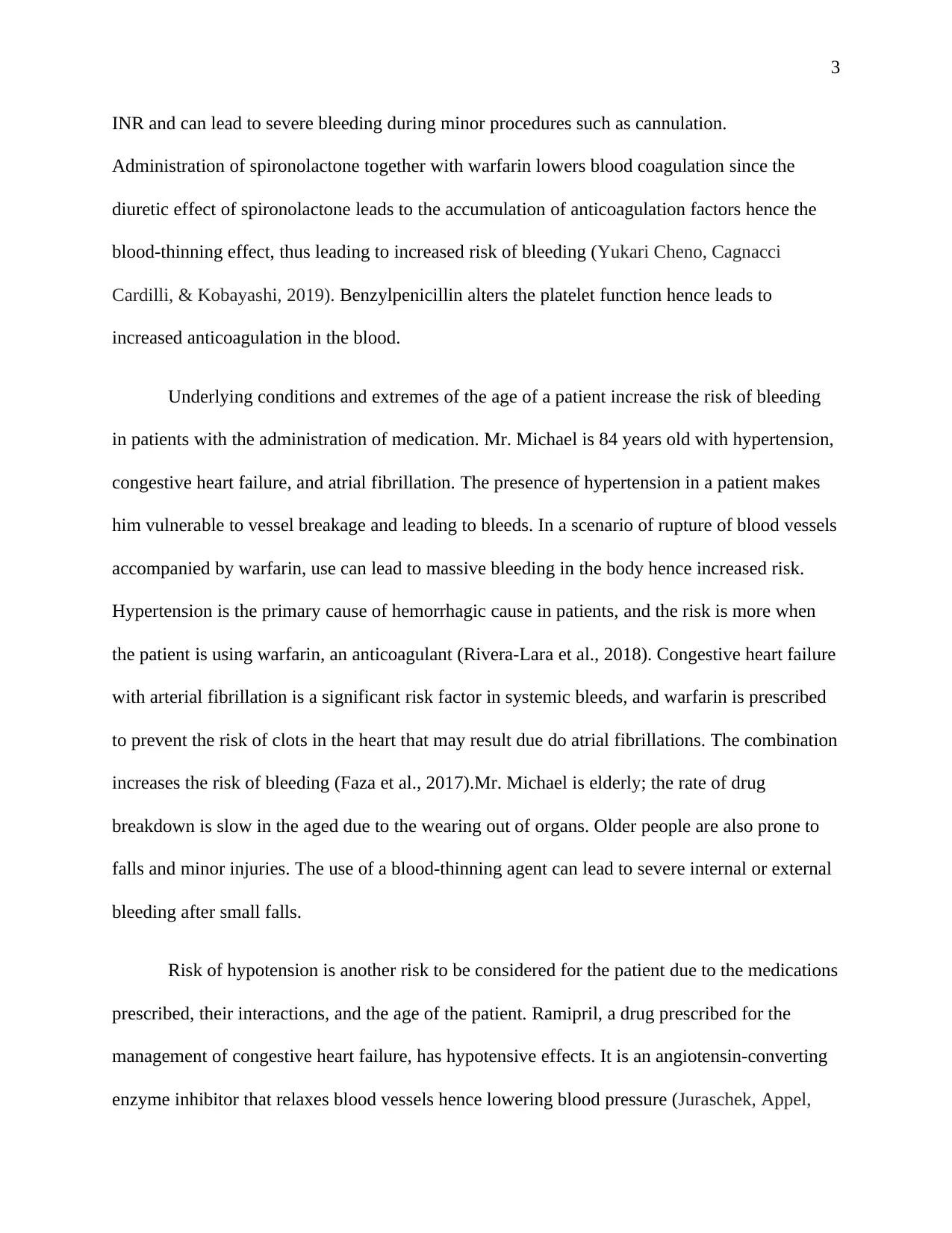
3
INR and can lead to severe bleeding during minor procedures such as cannulation.
Administration of spironolactone together with warfarin lowers blood coagulation since the
diuretic effect of spironolactone leads to the accumulation of anticoagulation factors hence the
blood-thinning effect, thus leading to increased risk of bleeding (Yukari Cheno, Cagnacci
Cardilli, & Kobayashi, 2019). Benzylpenicillin alters the platelet function hence leads to
increased anticoagulation in the blood.
Underlying conditions and extremes of the age of a patient increase the risk of bleeding
in patients with the administration of medication. Mr. Michael is 84 years old with hypertension,
congestive heart failure, and atrial fibrillation. The presence of hypertension in a patient makes
him vulnerable to vessel breakage and leading to bleeds. In a scenario of rupture of blood vessels
accompanied by warfarin, use can lead to massive bleeding in the body hence increased risk.
Hypertension is the primary cause of hemorrhagic cause in patients, and the risk is more when
the patient is using warfarin, an anticoagulant (Rivera-Lara et al., 2018). Congestive heart failure
with arterial fibrillation is a significant risk factor in systemic bleeds, and warfarin is prescribed
to prevent the risk of clots in the heart that may result due do atrial fibrillations. The combination
increases the risk of bleeding (Faza et al., 2017).Mr. Michael is elderly; the rate of drug
breakdown is slow in the aged due to the wearing out of organs. Older people are also prone to
falls and minor injuries. The use of a blood-thinning agent can lead to severe internal or external
bleeding after small falls.
Risk of hypotension is another risk to be considered for the patient due to the medications
prescribed, their interactions, and the age of the patient. Ramipril, a drug prescribed for the
management of congestive heart failure, has hypotensive effects. It is an angiotensin-converting
enzyme inhibitor that relaxes blood vessels hence lowering blood pressure (Juraschek, Appel,
INR and can lead to severe bleeding during minor procedures such as cannulation.
Administration of spironolactone together with warfarin lowers blood coagulation since the
diuretic effect of spironolactone leads to the accumulation of anticoagulation factors hence the
blood-thinning effect, thus leading to increased risk of bleeding (Yukari Cheno, Cagnacci
Cardilli, & Kobayashi, 2019). Benzylpenicillin alters the platelet function hence leads to
increased anticoagulation in the blood.
Underlying conditions and extremes of the age of a patient increase the risk of bleeding
in patients with the administration of medication. Mr. Michael is 84 years old with hypertension,
congestive heart failure, and atrial fibrillation. The presence of hypertension in a patient makes
him vulnerable to vessel breakage and leading to bleeds. In a scenario of rupture of blood vessels
accompanied by warfarin, use can lead to massive bleeding in the body hence increased risk.
Hypertension is the primary cause of hemorrhagic cause in patients, and the risk is more when
the patient is using warfarin, an anticoagulant (Rivera-Lara et al., 2018). Congestive heart failure
with arterial fibrillation is a significant risk factor in systemic bleeds, and warfarin is prescribed
to prevent the risk of clots in the heart that may result due do atrial fibrillations. The combination
increases the risk of bleeding (Faza et al., 2017).Mr. Michael is elderly; the rate of drug
breakdown is slow in the aged due to the wearing out of organs. Older people are also prone to
falls and minor injuries. The use of a blood-thinning agent can lead to severe internal or external
bleeding after small falls.
Risk of hypotension is another risk to be considered for the patient due to the medications
prescribed, their interactions, and the age of the patient. Ramipril, a drug prescribed for the
management of congestive heart failure, has hypotensive effects. It is an angiotensin-converting
enzyme inhibitor that relaxes blood vessels hence lowering blood pressure (Juraschek, Appel,
⊘ This is a preview!⊘
Do you want full access?
Subscribe today to unlock all pages.

Trusted by 1+ million students worldwide
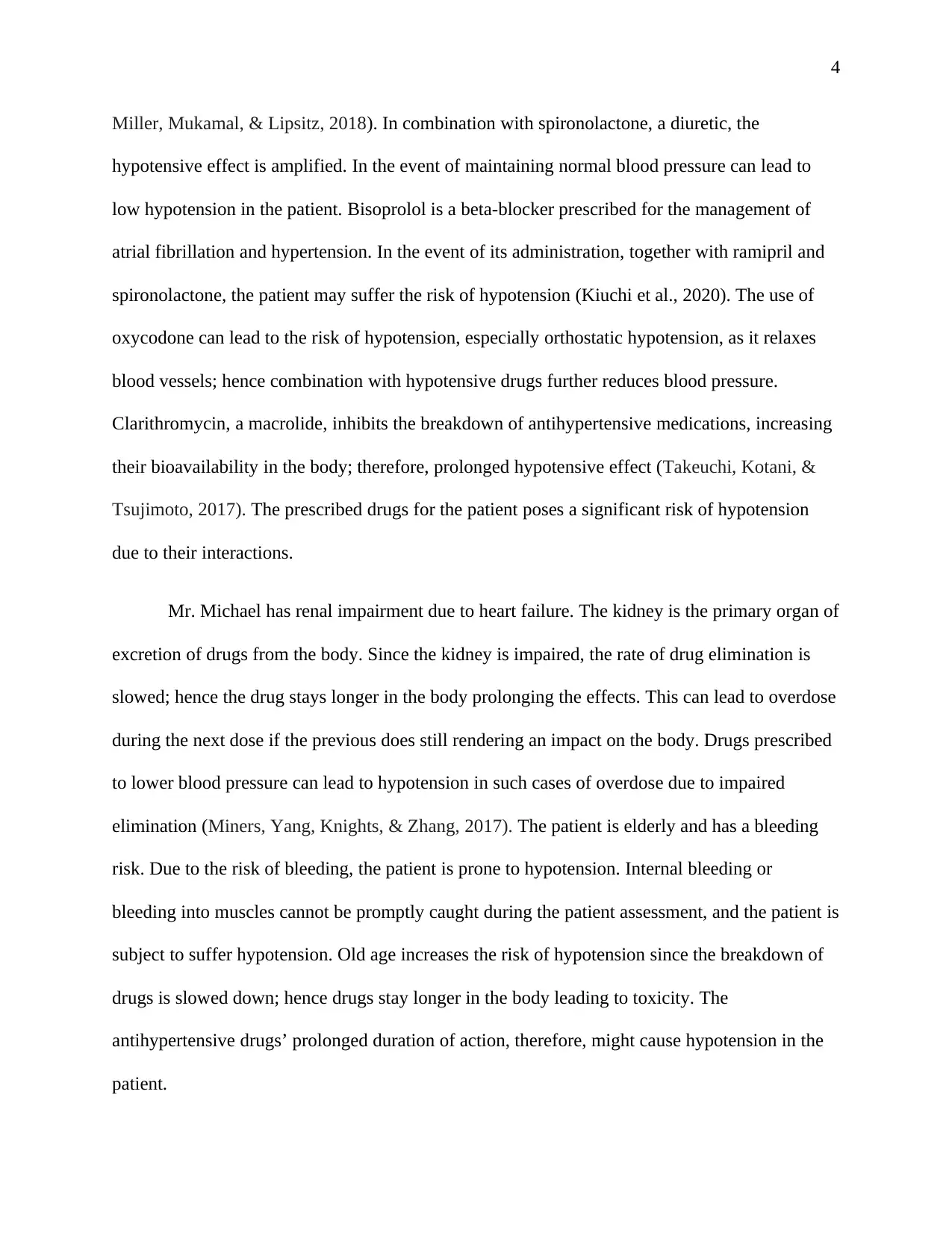
4
Miller, Mukamal, & Lipsitz, 2018). In combination with spironolactone, a diuretic, the
hypotensive effect is amplified. In the event of maintaining normal blood pressure can lead to
low hypotension in the patient. Bisoprolol is a beta-blocker prescribed for the management of
atrial fibrillation and hypertension. In the event of its administration, together with ramipril and
spironolactone, the patient may suffer the risk of hypotension (Kiuchi et al., 2020). The use of
oxycodone can lead to the risk of hypotension, especially orthostatic hypotension, as it relaxes
blood vessels; hence combination with hypotensive drugs further reduces blood pressure.
Clarithromycin, a macrolide, inhibits the breakdown of antihypertensive medications, increasing
their bioavailability in the body; therefore, prolonged hypotensive effect (Takeuchi, Kotani, &
Tsujimoto, 2017). The prescribed drugs for the patient poses a significant risk of hypotension
due to their interactions.
Mr. Michael has renal impairment due to heart failure. The kidney is the primary organ of
excretion of drugs from the body. Since the kidney is impaired, the rate of drug elimination is
slowed; hence the drug stays longer in the body prolonging the effects. This can lead to overdose
during the next dose if the previous does still rendering an impact on the body. Drugs prescribed
to lower blood pressure can lead to hypotension in such cases of overdose due to impaired
elimination (Miners, Yang, Knights, & Zhang, 2017). The patient is elderly and has a bleeding
risk. Due to the risk of bleeding, the patient is prone to hypotension. Internal bleeding or
bleeding into muscles cannot be promptly caught during the patient assessment, and the patient is
subject to suffer hypotension. Old age increases the risk of hypotension since the breakdown of
drugs is slowed down; hence drugs stay longer in the body leading to toxicity. The
antihypertensive drugs’ prolonged duration of action, therefore, might cause hypotension in the
patient.
Miller, Mukamal, & Lipsitz, 2018). In combination with spironolactone, a diuretic, the
hypotensive effect is amplified. In the event of maintaining normal blood pressure can lead to
low hypotension in the patient. Bisoprolol is a beta-blocker prescribed for the management of
atrial fibrillation and hypertension. In the event of its administration, together with ramipril and
spironolactone, the patient may suffer the risk of hypotension (Kiuchi et al., 2020). The use of
oxycodone can lead to the risk of hypotension, especially orthostatic hypotension, as it relaxes
blood vessels; hence combination with hypotensive drugs further reduces blood pressure.
Clarithromycin, a macrolide, inhibits the breakdown of antihypertensive medications, increasing
their bioavailability in the body; therefore, prolonged hypotensive effect (Takeuchi, Kotani, &
Tsujimoto, 2017). The prescribed drugs for the patient poses a significant risk of hypotension
due to their interactions.
Mr. Michael has renal impairment due to heart failure. The kidney is the primary organ of
excretion of drugs from the body. Since the kidney is impaired, the rate of drug elimination is
slowed; hence the drug stays longer in the body prolonging the effects. This can lead to overdose
during the next dose if the previous does still rendering an impact on the body. Drugs prescribed
to lower blood pressure can lead to hypotension in such cases of overdose due to impaired
elimination (Miners, Yang, Knights, & Zhang, 2017). The patient is elderly and has a bleeding
risk. Due to the risk of bleeding, the patient is prone to hypotension. Internal bleeding or
bleeding into muscles cannot be promptly caught during the patient assessment, and the patient is
subject to suffer hypotension. Old age increases the risk of hypotension since the breakdown of
drugs is slowed down; hence drugs stay longer in the body leading to toxicity. The
antihypertensive drugs’ prolonged duration of action, therefore, might cause hypotension in the
patient.
Paraphrase This Document
Need a fresh take? Get an instant paraphrase of this document with our AI Paraphraser

5
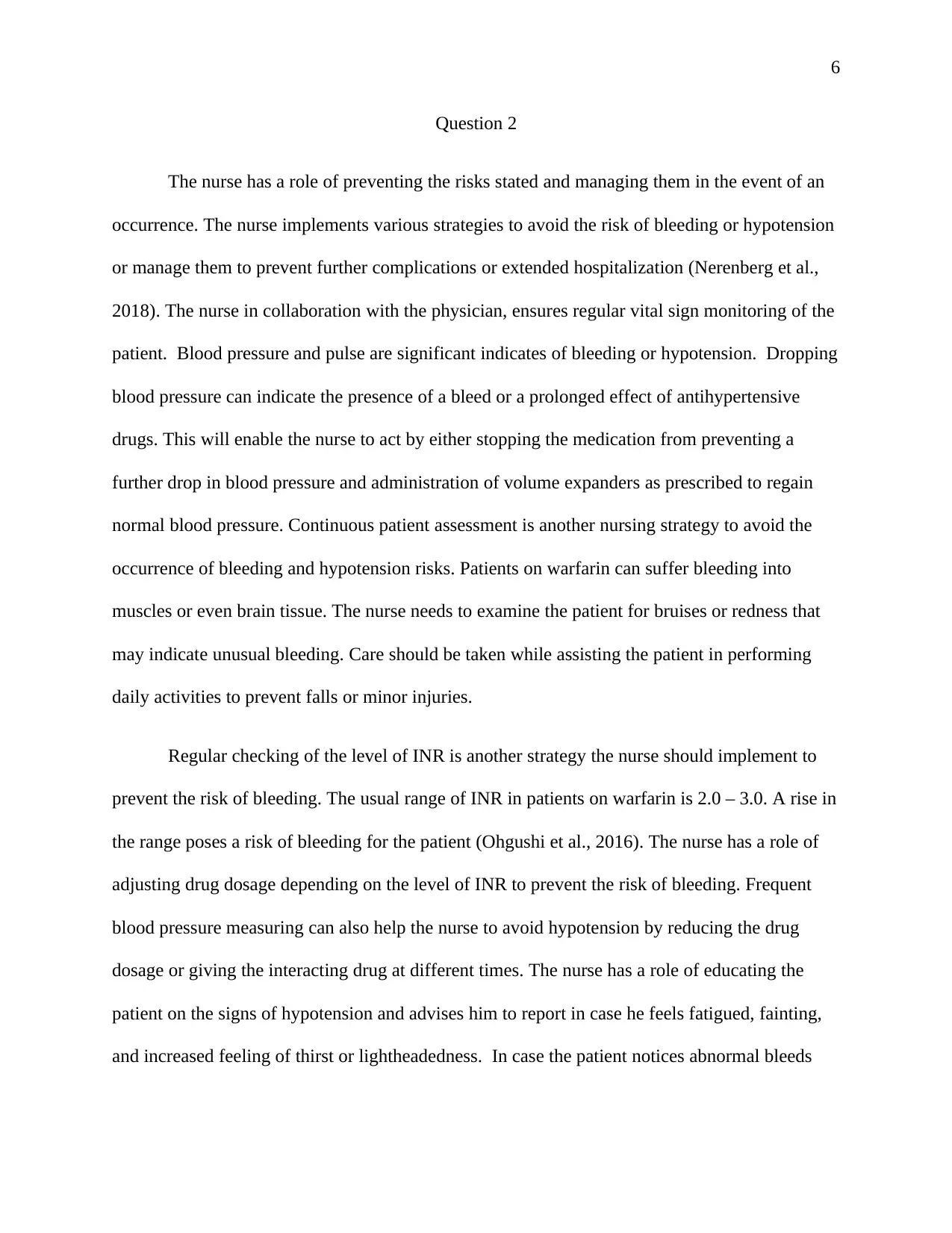
6
Question 2
The nurse has a role of preventing the risks stated and managing them in the event of an
occurrence. The nurse implements various strategies to avoid the risk of bleeding or hypotension
or manage them to prevent further complications or extended hospitalization (Nerenberg et al.,
2018). The nurse in collaboration with the physician, ensures regular vital sign monitoring of the
patient. Blood pressure and pulse are significant indicates of bleeding or hypotension. Dropping
blood pressure can indicate the presence of a bleed or a prolonged effect of antihypertensive
drugs. This will enable the nurse to act by either stopping the medication from preventing a
further drop in blood pressure and administration of volume expanders as prescribed to regain
normal blood pressure. Continuous patient assessment is another nursing strategy to avoid the
occurrence of bleeding and hypotension risks. Patients on warfarin can suffer bleeding into
muscles or even brain tissue. The nurse needs to examine the patient for bruises or redness that
may indicate unusual bleeding. Care should be taken while assisting the patient in performing
daily activities to prevent falls or minor injuries.
Regular checking of the level of INR is another strategy the nurse should implement to
prevent the risk of bleeding. The usual range of INR in patients on warfarin is 2.0 – 3.0. A rise in
the range poses a risk of bleeding for the patient (Ohgushi et al., 2016). The nurse has a role of
adjusting drug dosage depending on the level of INR to prevent the risk of bleeding. Frequent
blood pressure measuring can also help the nurse to avoid hypotension by reducing the drug
dosage or giving the interacting drug at different times. The nurse has a role of educating the
patient on the signs of hypotension and advises him to report in case he feels fatigued, fainting,
and increased feeling of thirst or lightheadedness. In case the patient notices abnormal bleeds
Question 2
The nurse has a role of preventing the risks stated and managing them in the event of an
occurrence. The nurse implements various strategies to avoid the risk of bleeding or hypotension
or manage them to prevent further complications or extended hospitalization (Nerenberg et al.,
2018). The nurse in collaboration with the physician, ensures regular vital sign monitoring of the
patient. Blood pressure and pulse are significant indicates of bleeding or hypotension. Dropping
blood pressure can indicate the presence of a bleed or a prolonged effect of antihypertensive
drugs. This will enable the nurse to act by either stopping the medication from preventing a
further drop in blood pressure and administration of volume expanders as prescribed to regain
normal blood pressure. Continuous patient assessment is another nursing strategy to avoid the
occurrence of bleeding and hypotension risks. Patients on warfarin can suffer bleeding into
muscles or even brain tissue. The nurse needs to examine the patient for bruises or redness that
may indicate unusual bleeding. Care should be taken while assisting the patient in performing
daily activities to prevent falls or minor injuries.
Regular checking of the level of INR is another strategy the nurse should implement to
prevent the risk of bleeding. The usual range of INR in patients on warfarin is 2.0 – 3.0. A rise in
the range poses a risk of bleeding for the patient (Ohgushi et al., 2016). The nurse has a role of
adjusting drug dosage depending on the level of INR to prevent the risk of bleeding. Frequent
blood pressure measuring can also help the nurse to avoid hypotension by reducing the drug
dosage or giving the interacting drug at different times. The nurse has a role of educating the
patient on the signs of hypotension and advises him to report in case he feels fatigued, fainting,
and increased feeling of thirst or lightheadedness. In case the patient notices abnormal bleeds
⊘ This is a preview!⊘
Do you want full access?
Subscribe today to unlock all pages.

Trusted by 1+ million students worldwide
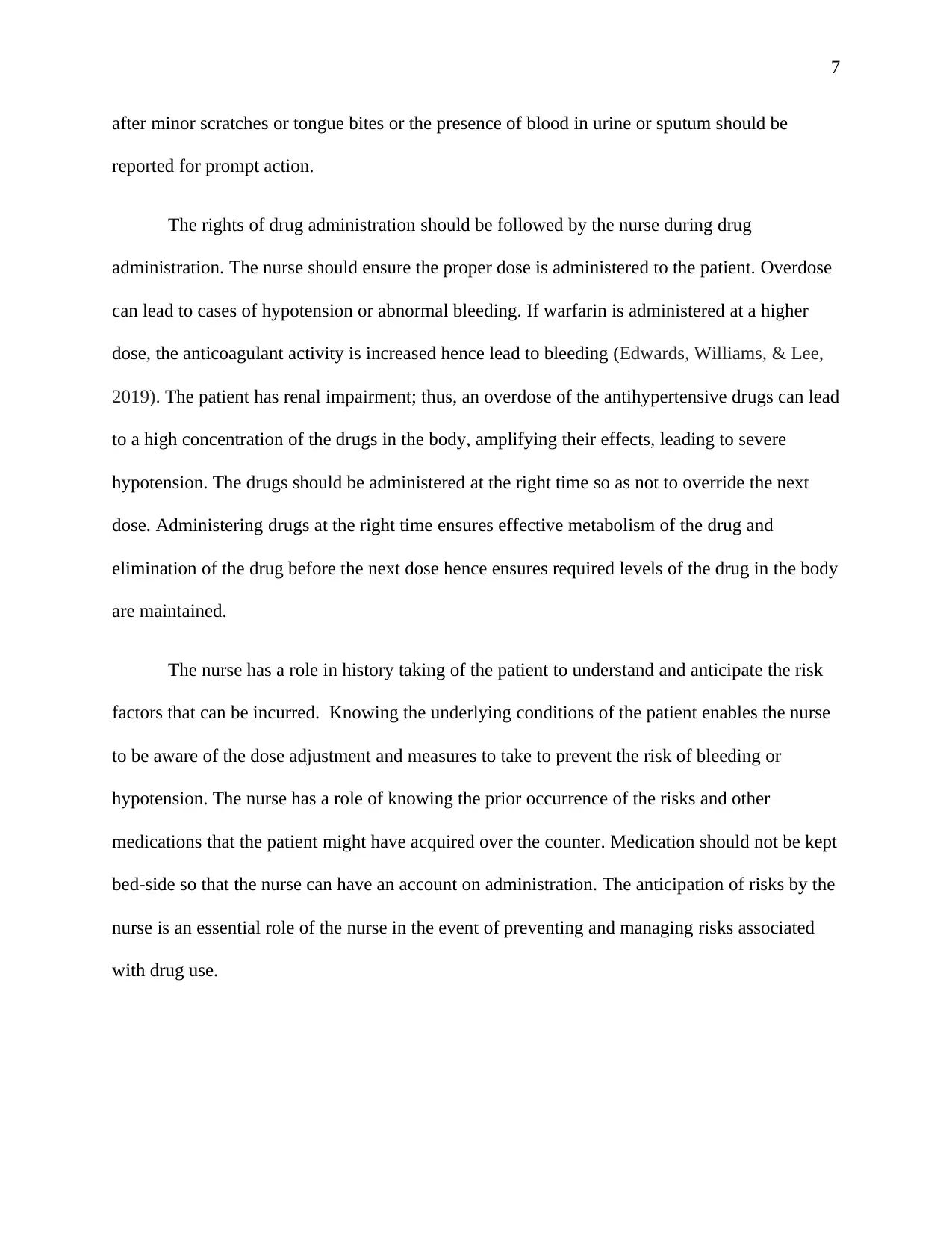
7
after minor scratches or tongue bites or the presence of blood in urine or sputum should be
reported for prompt action.
The rights of drug administration should be followed by the nurse during drug
administration. The nurse should ensure the proper dose is administered to the patient. Overdose
can lead to cases of hypotension or abnormal bleeding. If warfarin is administered at a higher
dose, the anticoagulant activity is increased hence lead to bleeding (Edwards, Williams, & Lee,
2019). The patient has renal impairment; thus, an overdose of the antihypertensive drugs can lead
to a high concentration of the drugs in the body, amplifying their effects, leading to severe
hypotension. The drugs should be administered at the right time so as not to override the next
dose. Administering drugs at the right time ensures effective metabolism of the drug and
elimination of the drug before the next dose hence ensures required levels of the drug in the body
are maintained.
The nurse has a role in history taking of the patient to understand and anticipate the risk
factors that can be incurred. Knowing the underlying conditions of the patient enables the nurse
to be aware of the dose adjustment and measures to take to prevent the risk of bleeding or
hypotension. The nurse has a role of knowing the prior occurrence of the risks and other
medications that the patient might have acquired over the counter. Medication should not be kept
bed-side so that the nurse can have an account on administration. The anticipation of risks by the
nurse is an essential role of the nurse in the event of preventing and managing risks associated
with drug use.
after minor scratches or tongue bites or the presence of blood in urine or sputum should be
reported for prompt action.
The rights of drug administration should be followed by the nurse during drug
administration. The nurse should ensure the proper dose is administered to the patient. Overdose
can lead to cases of hypotension or abnormal bleeding. If warfarin is administered at a higher
dose, the anticoagulant activity is increased hence lead to bleeding (Edwards, Williams, & Lee,
2019). The patient has renal impairment; thus, an overdose of the antihypertensive drugs can lead
to a high concentration of the drugs in the body, amplifying their effects, leading to severe
hypotension. The drugs should be administered at the right time so as not to override the next
dose. Administering drugs at the right time ensures effective metabolism of the drug and
elimination of the drug before the next dose hence ensures required levels of the drug in the body
are maintained.
The nurse has a role in history taking of the patient to understand and anticipate the risk
factors that can be incurred. Knowing the underlying conditions of the patient enables the nurse
to be aware of the dose adjustment and measures to take to prevent the risk of bleeding or
hypotension. The nurse has a role of knowing the prior occurrence of the risks and other
medications that the patient might have acquired over the counter. Medication should not be kept
bed-side so that the nurse can have an account on administration. The anticipation of risks by the
nurse is an essential role of the nurse in the event of preventing and managing risks associated
with drug use.
Paraphrase This Document
Need a fresh take? Get an instant paraphrase of this document with our AI Paraphraser
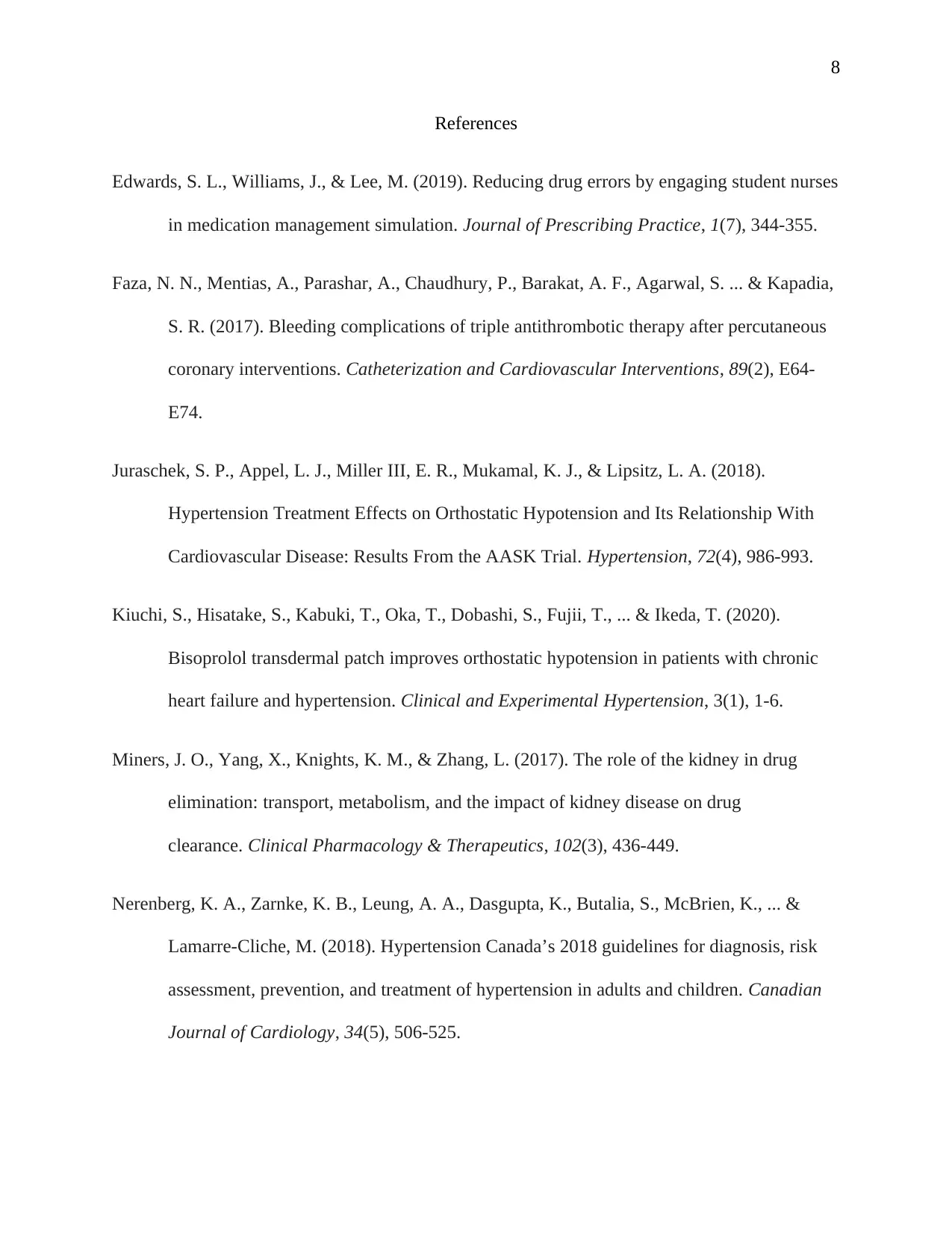
8
References
Edwards, S. L., Williams, J., & Lee, M. (2019). Reducing drug errors by engaging student nurses
in medication management simulation. Journal of Prescribing Practice, 1(7), 344-355.
Faza, N. N., Mentias, A., Parashar, A., Chaudhury, P., Barakat, A. F., Agarwal, S. ... & Kapadia,
S. R. (2017). Bleeding complications of triple antithrombotic therapy after percutaneous
coronary interventions. Catheterization and Cardiovascular Interventions, 89(2), E64-
E74.
Juraschek, S. P., Appel, L. J., Miller III, E. R., Mukamal, K. J., & Lipsitz, L. A. (2018).
Hypertension Treatment Effects on Orthostatic Hypotension and Its Relationship With
Cardiovascular Disease: Results From the AASK Trial. Hypertension, 72(4), 986-993.
Kiuchi, S., Hisatake, S., Kabuki, T., Oka, T., Dobashi, S., Fujii, T., ... & Ikeda, T. (2020).
Bisoprolol transdermal patch improves orthostatic hypotension in patients with chronic
heart failure and hypertension. Clinical and Experimental Hypertension, 3(1), 1-6.
Miners, J. O., Yang, X., Knights, K. M., & Zhang, L. (2017). The role of the kidney in drug
elimination: transport, metabolism, and the impact of kidney disease on drug
clearance. Clinical Pharmacology & Therapeutics, 102(3), 436-449.
Nerenberg, K. A., Zarnke, K. B., Leung, A. A., Dasgupta, K., Butalia, S., McBrien, K., ... &
Lamarre-Cliche, M. (2018). Hypertension Canada’s 2018 guidelines for diagnosis, risk
assessment, prevention, and treatment of hypertension in adults and children. Canadian
Journal of Cardiology, 34(5), 506-525.
References
Edwards, S. L., Williams, J., & Lee, M. (2019). Reducing drug errors by engaging student nurses
in medication management simulation. Journal of Prescribing Practice, 1(7), 344-355.
Faza, N. N., Mentias, A., Parashar, A., Chaudhury, P., Barakat, A. F., Agarwal, S. ... & Kapadia,
S. R. (2017). Bleeding complications of triple antithrombotic therapy after percutaneous
coronary interventions. Catheterization and Cardiovascular Interventions, 89(2), E64-
E74.
Juraschek, S. P., Appel, L. J., Miller III, E. R., Mukamal, K. J., & Lipsitz, L. A. (2018).
Hypertension Treatment Effects on Orthostatic Hypotension and Its Relationship With
Cardiovascular Disease: Results From the AASK Trial. Hypertension, 72(4), 986-993.
Kiuchi, S., Hisatake, S., Kabuki, T., Oka, T., Dobashi, S., Fujii, T., ... & Ikeda, T. (2020).
Bisoprolol transdermal patch improves orthostatic hypotension in patients with chronic
heart failure and hypertension. Clinical and Experimental Hypertension, 3(1), 1-6.
Miners, J. O., Yang, X., Knights, K. M., & Zhang, L. (2017). The role of the kidney in drug
elimination: transport, metabolism, and the impact of kidney disease on drug
clearance. Clinical Pharmacology & Therapeutics, 102(3), 436-449.
Nerenberg, K. A., Zarnke, K. B., Leung, A. A., Dasgupta, K., Butalia, S., McBrien, K., ... &
Lamarre-Cliche, M. (2018). Hypertension Canada’s 2018 guidelines for diagnosis, risk
assessment, prevention, and treatment of hypertension in adults and children. Canadian
Journal of Cardiology, 34(5), 506-525.
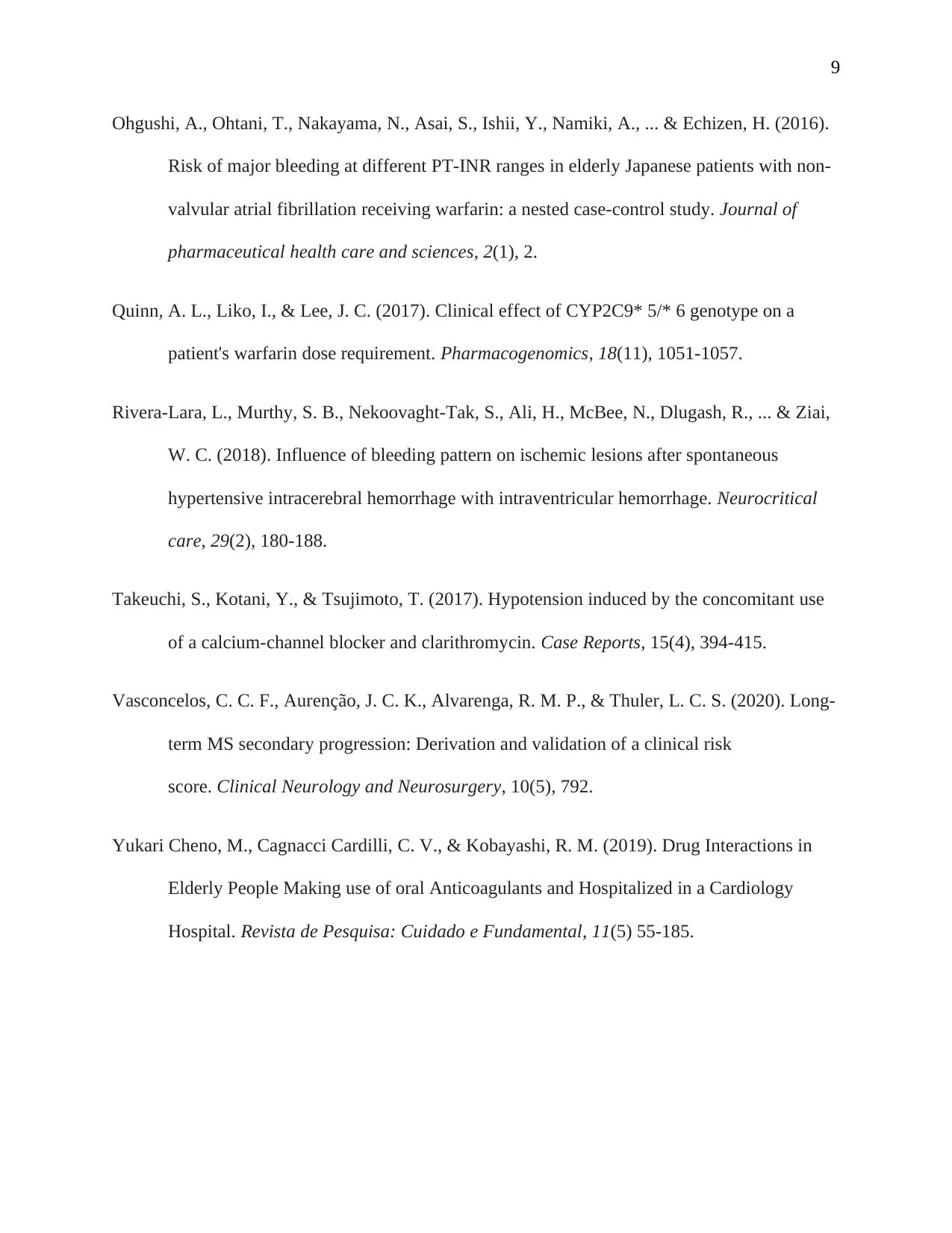
9
Ohgushi, A., Ohtani, T., Nakayama, N., Asai, S., Ishii, Y., Namiki, A., ... & Echizen, H. (2016).
Risk of major bleeding at different PT-INR ranges in elderly Japanese patients with non-
valvular atrial fibrillation receiving warfarin: a nested case-control study. Journal of
pharmaceutical health care and sciences, 2(1), 2.
Quinn, A. L., Liko, I., & Lee, J. C. (2017). Clinical effect of CYP2C9* 5/* 6 genotype on a
patient's warfarin dose requirement. Pharmacogenomics, 18(11), 1051-1057.
Rivera-Lara, L., Murthy, S. B., Nekoovaght-Tak, S., Ali, H., McBee, N., Dlugash, R., ... & Ziai,
W. C. (2018). Influence of bleeding pattern on ischemic lesions after spontaneous
hypertensive intracerebral hemorrhage with intraventricular hemorrhage. Neurocritical
care, 29(2), 180-188.
Takeuchi, S., Kotani, Y., & Tsujimoto, T. (2017). Hypotension induced by the concomitant use
of a calcium-channel blocker and clarithromycin. Case Reports, 15(4), 394-415.
Vasconcelos, C. C. F., Aurenção, J. C. K., Alvarenga, R. M. P., & Thuler, L. C. S. (2020). Long-
term MS secondary progression: Derivation and validation of a clinical risk
score. Clinical Neurology and Neurosurgery, 10(5), 792.
Yukari Cheno, M., Cagnacci Cardilli, C. V., & Kobayashi, R. M. (2019). Drug Interactions in
Elderly People Making use of oral Anticoagulants and Hospitalized in a Cardiology
Hospital. Revista de Pesquisa: Cuidado e Fundamental, 11(5) 55-185.
Ohgushi, A., Ohtani, T., Nakayama, N., Asai, S., Ishii, Y., Namiki, A., ... & Echizen, H. (2016).
Risk of major bleeding at different PT-INR ranges in elderly Japanese patients with non-
valvular atrial fibrillation receiving warfarin: a nested case-control study. Journal of
pharmaceutical health care and sciences, 2(1), 2.
Quinn, A. L., Liko, I., & Lee, J. C. (2017). Clinical effect of CYP2C9* 5/* 6 genotype on a
patient's warfarin dose requirement. Pharmacogenomics, 18(11), 1051-1057.
Rivera-Lara, L., Murthy, S. B., Nekoovaght-Tak, S., Ali, H., McBee, N., Dlugash, R., ... & Ziai,
W. C. (2018). Influence of bleeding pattern on ischemic lesions after spontaneous
hypertensive intracerebral hemorrhage with intraventricular hemorrhage. Neurocritical
care, 29(2), 180-188.
Takeuchi, S., Kotani, Y., & Tsujimoto, T. (2017). Hypotension induced by the concomitant use
of a calcium-channel blocker and clarithromycin. Case Reports, 15(4), 394-415.
Vasconcelos, C. C. F., Aurenção, J. C. K., Alvarenga, R. M. P., & Thuler, L. C. S. (2020). Long-
term MS secondary progression: Derivation and validation of a clinical risk
score. Clinical Neurology and Neurosurgery, 10(5), 792.
Yukari Cheno, M., Cagnacci Cardilli, C. V., & Kobayashi, R. M. (2019). Drug Interactions in
Elderly People Making use of oral Anticoagulants and Hospitalized in a Cardiology
Hospital. Revista de Pesquisa: Cuidado e Fundamental, 11(5) 55-185.
⊘ This is a preview!⊘
Do you want full access?
Subscribe today to unlock all pages.

Trusted by 1+ million students worldwide
1 out of 9
Related Documents
Your All-in-One AI-Powered Toolkit for Academic Success.
+13062052269
info@desklib.com
Available 24*7 on WhatsApp / Email
![[object Object]](/_next/static/media/star-bottom.7253800d.svg)
Unlock your academic potential
Copyright © 2020–2025 A2Z Services. All Rights Reserved. Developed and managed by ZUCOL.





